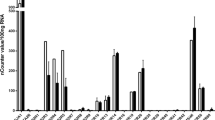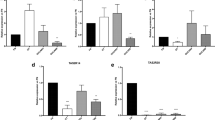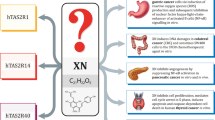Abstract
The emerging significance of the bitter taste receptors (T2Rs) role in the extraoral tissues alludes to their potential role in many pathophysiological conditions. The dysregulation of T2R expression and function in disease conditions has now been demonstrated in airways diseases, neurological disorders, and in some cancers. However, the role of T2Rs in the pathophysiology of breast cancer is unexplored thus far. Previously, we demonstrated differential expression of the 25 T2Rs in breast cancer (BC) cells. Based on our previous findings we selected two T2Rs, T2R4 and T2R14 for this work. The objective of the current study is to investigate the expression of T2R4 and T2R14 in BC clinical samples and to examine their physiological role using highly metastatic BC and non-cancerous cell lines. Using approaches, which involve receptor knockdown, pharmacological activation and biochemical assays we report that (i) T2R4 and T2R14 expression patterns are dissimilar, with decreased levels of T2R4 and increased levels of T2R14 in BC clinical samples compared to non-cancerous controls. (ii) Activation of T2Rs with their respective agonist elicited physiological responses in metastatic breast cancer cells, and no responses were seen in non-tumorigenic breast epithelial cells. (iii) Agonist activation of T2Rs (irrespective of T2R subtype) induced anti-proliferative, pro-apoptotic, and anti-migratory responses in highly metastatic breast cancer cells. Taken together, our findings demonstrate that the chemosensory T2R signaling network is involved in evoking physiological responses in the metastatic breast cancer cell line.








Similar content being viewed by others
Abbreviations
- API:
-
Apigenin
- BC:
-
Breast cancer
- FOXM1:
-
Forkhead box M1
- GPCR:
-
G protein-coupled receptor
- hEGF:
-
Human epidermal growth factor
- PPARα1:
-
Peroxisome proliferator-activated receptor α1
- QUI:
-
Quinine
- qPCR:
-
Quantitative polymerase chain reaction
- shRNA:
-
Short hairpin RNA
- T2R:
-
Bitter taste receptor
- TNBC:
-
Triple-negative breast cancer
References
Coughlin SS, Ekwueme DU (2009) Breast cancer as a global health concern. Cancer Epidemiol 33:315–318. https://doi.org/10.1016/j.canep.2009.10.003
Dorsam RT, Gutkind JS (2007) G-protein-coupled receptors and cancer. Nat Rev Cancer 7:79–94. https://doi.org/10.1038/nrc2069
Liu Y, An S, Ward R, Yang Y, Guo XX, Li W, Xu TR (2016) G protein-coupled receptors as promising cancer targets. Cancer Lett 376:226–239. https://doi.org/10.1016/j.canlet.2016.03.031
Nieto Gutierrez A, McDonald PH (2018) GPCRs: emerging anti-cancer drug targets. Cell Signal 41:65–74. https://doi.org/10.1016/j.cellsig.2017.09.005
Adler E, Hoon MA, Mueller KL, Chandrashekar J, Ryba NJ, Zuker CS (2000) A novel family of mammalian taste receptors. Cell 100:693–702
Chandrashekar J, Mueller KL, Hoon MA, Adler E, Feng L, Guo W, Zuker CS, Ryba NJ (2000) T2Rs function as bitter taste receptors. Cell 100:703–711
Munk C, Isberg V, Mordalski S, Harpsoe K, Rataj K, Hauser AS, Kolb P, Bojarski AJ, Vriend G, Gloriam DE (2016) GPCRdb: the G protein-coupled receptor database—an introduction. Br J Pharmacol 173:2195–2207. https://doi.org/10.1111/bph.13509
Shaik FA, Singh N, Arakawa M, Duan K, Bhullar RP, Chelikani P (2016) Bitter taste receptors: extraoral roles in pathophysiology. Int J Biochem Cell Biol 77:197–204. https://doi.org/10.1016/j.biocel.2016.03.011
Lu P, Zhang CH, Lifshitz LM, ZhuGe R (2017) Extraoral bitter taste receptors in health and disease. J Gen Physiol 149:181–197. https://doi.org/10.1085/jgp.201611637
Deshpande DA, Wang WC, McIlmoyle EL, Robinett KS, Schillinger RM, An SS, Sham JS, Liggett SB (2010) Bitter taste receptors on airway smooth muscle bronchodilate by localized calcium signaling and reverse obstruction. Nat Med 16:1299–1304. https://doi.org/10.1038/nm.2237
Lee RJ, Xiong G, Kofonow JM, Chen B, Lysenko A, Jiang P, Abraham V, Doghramji L, Adappa ND, Palmer JN, Kennedy DW, Beauchamp GK, Doulias PT, Ischiropoulos H, Kreindler JL, Reed DR, Cohen NA (2012) T2R38 taste receptor polymorphisms underlie susceptibility to upper respiratory infection. J Clin Invest 122:4145–4159. https://doi.org/10.1172/JCI64240
Sharma P, Yi R, Nayak AP, Wang N, Tang F, Knight MJ, Pan S, Oliver B, Deshpande DA (2017) Bitter taste receptor agonists mitigate features of allergic asthma in mice. Sci Rep 7:46166. https://doi.org/10.1038/srep46166
Robinett KS, Koziol-White CJ, Akoluk A, An SS, Panettieri RA Jr, Liggett SB (2014) Bitter taste receptor function in asthmatic and nonasthmatic human airway smooth muscle cells. Am J Respir Cell Mol Biol 50:678–683. https://doi.org/10.1165/rcmb.2013-0439RC
Kim KH, Lee IS, Park JY, Kim Y, An EJ, Jang HJ (2018) Cucurbitacin B Induces hypoglycemic effect in diabetic mice by regulation of AMP-activated protein kinase alpha and glucagon-like peptide-1 via bitter taste receptor signaling. Front Pharmacol 9:1071. https://doi.org/10.3389/fphar.2018.01071
Jeon TI, Zhu B, Larson JL, Osborne TF (2008) SREBP-2 regulates gut peptide secretion through intestinal bitter taste receptor signaling in mice. J Clin Investig 118:3693–3700
Clark AA, Dotson CD, Elson AE, Voigt A, Boehm U, Meyerhof W, Steinle NI, Munger SD (2015) TAS2R bitter taste receptors regulate thyroid function. FASEB J 29:164–172. https://doi.org/10.1096/fj.14-262246
Ansoleaga B, Garcia-Esparcia P, Pinacho R, Haro JM, Ramos B, Ferrer I (2015) Decrease in olfactory and taste receptor expression in the dorsolateral prefrontal cortex in chronic schizophrenia. J Psychiatr Res 60:109–116. https://doi.org/10.1016/j.jpsychires.2014.09.012
Gaida MM, Mayer C, Dapunt U, Stegmaier S, Schirmacher P, Wabnitz GH, Hansch GM (2016) Expression of the bitter receptor T2R38 in pancreatic cancer: localization in lipid droplets and activation by a bacteria-derived quorum-sensing molecule. Oncotarget 7:12623–12632. https://doi.org/10.18632/oncotarget.7206
Stern L, Giese N, Hackert T, Strobel O, Schirmacher P, Felix K, Gaida MM (2018) Overcoming chemoresistance in pancreatic cancer cells: role of the bitter taste receptor T2R10. J Cancer 9:711–725. https://doi.org/10.7150/jca.21803
Seo Y, Kim YS, Lee KE, Park TH, Kim Y (2017) Anti-cancer stemness and anti-invasive activity of bitter taste receptors, TAS2R8 and TAS2R10, in human neuroblastoma cells. PLoS ONE 12:e0176851. https://doi.org/10.1371/journal.pone.0176851
Martin LTP, Nachtigal MW, Selman T, Nguyen E, Salsman J, Dellaire G, Dupre DJ (2018) Bitter taste receptors are expressed in human epithelial ovarian and prostate cancers cells and noscapine stimulation impacts cell survival. Mol Cell Biochem. https://doi.org/10.1007/s11010-018-3464-z
Carrai M, Steinke V, Vodicka P, Pardini B, Rahner N, Holinski-Feder E, Morak M, Schackert HK, Gorgens H, Stemmler S, Betz B, Kloor M, Engel C, Buttner R, Naccarati A, Vodickova L, Novotny J, Stein A, Hemminki K, Propping P, Forsti A, Canzian F, Barale R, Campa D (2011) Association between TAS2R38 gene polymorphisms and colorectal cancer risk: a case-control study in two independent populations of Caucasian origin. PLoS ONE 6:e20464. https://doi.org/10.1371/journal.pone.0020464
Lambert JD, VanDusen SR, Cockroft JE, Smith EC, Greenwood DC, Cade JE (2018) Bitter taste sensitivity, food intake, and risk of malignant cancer in the UK Women's cohort study. Eur J Nutr. https://doi.org/10.1007/s00394-018-1772-4
Yamaki M, Saito H, Isono K, Goto T, Shirakawa H, Shoji N, Satoh-Kuriwada S, Sasano T, Okada R, Kudoh K, Motoi F, Unno M, Komai M (2017) Genotyping analysis of bitter-taste receptor genes TAS2R38 and TAS2R46 in Japanese patients with gastrointestinal cancers. J Nutr Sci Vitaminol (Tokyo) 63:148–154. https://doi.org/10.3177/jnsv.63.148
Choi JH, Lee J, Yang S, Lee EK, Hwangbo Y, Kim J (2018) Genetic variations in TAS2R3 and TAS2R4 bitterness receptors modify papillary carcinoma risk and thyroid function in Korean females. Sci Rep 8:15004. https://doi.org/10.1038/s41598-018-33338-6
Levitsky DO, Dembitsky VM (2014) Anti-breast cancer agents derived from plants. Nat Prod Bioprospect. https://doi.org/10.1007/s13659-014-0048-9
Muhammad N, Steele R, Isbell TS, Philips N, Ray RB (2017) Bitter melon extract inhibits breast cancer growth in preclinical model by inducing autophagic cell death. Oncotarget 8:66226–66236. https://doi.org/10.18632/oncotarget.19887
Jeong JH, An JY, Kwon YT, Rhee JG, Lee YJ (2009) Effects of low dose quercetin: cancer cell-specific inhibition of cell cycle progression. J Cell Biochem 106:73–82. https://doi.org/10.1002/jcb.21977
Lin CH, Chang CY, Lee KR, Lin HJ, Chen TH, Wan L (2015) Flavones inhibit breast cancer proliferation through the Akt/FOXO3a signaling pathway. BMC Cancer 15:958. https://doi.org/10.1186/s12885-015-1965-7
Seo HS, Jo JK, Ku JM, Choi HS, Choi YK, Woo JK, Kim HI, Kang SY, Lee KM, Nam KW, Park N, Jang BH, Shin YC, Ko SG (2015) Induction of caspase-dependent extrinsic apoptosis by apigenin through inhibition of signal transducer and activator of transcription 3 (STAT3) signalling in HER2-overexpressing BT-474 breast cancer cells. Biosci Rep. https://doi.org/10.1042/BSR20150165
Bauer D, Redmon N, Mazzio E, Soliman KF (2017) Apigenin inhibits TNFalpha/IL-1alpha-induced CCL2 release through IKBK-epsilon signaling in MDA-MB-231 human breast cancer cells. PLoS ONE 12:e0175558. https://doi.org/10.1371/journal.pone.0175558
Lin CM, Chen HH, Lin CA, Wu HC, Sheu JJ, Chen HJ (2017) Apigenin-induced lysosomal degradation of beta-catenin in Wnt/beta-catenin signaling. Sci Rep 7:372. https://doi.org/10.1038/s41598-017-00409-z
Rivera Rivera A, Castillo-Pichardo L, Gerena Y, Dharmawardhane S (2016) Anti-Breast cancer potential of quercetin via the Akt/AMPK/mammalian target of rapamycin (mTOR) signaling cascade. PLoS ONE 11:e0157251. https://doi.org/10.1371/journal.pone.0157251
Hariri BM, McMahon DB, Chen B, Freund JR, Mansfield CJ, Doghramji LJ, Adappa ND, Palmer JN, Kennedy DW, Reed DR, Jiang P, Lee RJ (2017) Flavones modulate respiratory epithelial innate immunity: anti-inflammatory effects and activation of the T2R14 receptor. J Biol Chem 292:8484–8497. https://doi.org/10.1074/jbc.M116.771949
Roland WS, van Buren L, Gruppen H, Driesse M, Gouka RJ, Smit G, Vincken JP (2013) Bitter taste receptor activation by flavonoids and isoflavonoids: modeled structural requirements for activation of hTAS2R14 and hTAS2R39. J Agric Food Chem 61:10454–10466. https://doi.org/10.1021/jf403387p
Singh N, Chakraborty R, Bhullar RP, Chelikani P (2014) Differential expression of bitter taste receptors in non-cancerous breast epithelial and breast cancer cells. Biochem Biophys Res Commun 446:499–503. https://doi.org/10.1016/j.bbrc.2014.02.140
Jaggupilli A, Singh N, Upadhyaya J, Sikarwar AS, Arakawa M, Dakshinamurti S, Bhullar RP, Duan K, Chelikani P (2017) Analysis of the expression of human bitter taste receptors in extraoral tissues. Mol Cell Biochem 426:137–147. https://doi.org/10.1007/s11010-016-2902-z
Blanchard AA, Skliris GP, Watson PH, Murphy LC, Penner C, Tomes L, Young TL, Leygue E, Myal Y (2009) Claudins 1, 3, and 4 protein expression in ER negative breast cancer correlates with markers of the basal phenotype. Virchows Arch 454:647–656. https://doi.org/10.1007/s00428-009-0770-6
Skliris GP, Hube F, Gheorghiu I, Mutawe MM, Penner C, Watson PH, Murphy LC, Leygue E, Myal Y (2008) Expression of small breast epithelial mucin (SBEM) protein in tissue microarrays (TMAs) of primary invasive breast cancers. Histopathology 52:355–369. https://doi.org/10.1111/j.1365-2559.2007.02955.x
Livak KJ, Schmittgen TD (2001) Analysis of relative gene expression data using real-time quantitative PCR and the 2(-Delta Delta C(T)) Method. Methods 25:402–408. https://doi.org/10.1006/meth.2001.1262
Jaggupilli A, Singh N, De Jesus VC, Gounni MS, Dhanaraj P, Chelikani P (2018) Chemosensory bitter taste receptors (T2Rs) are activated by multiple antibiotics. FASEB J. https://doi.org/10.1096/fj.201800521RR
Jaggupilli A, Singh N, Jesus VC, Duan K, Chelikani P (2018) Characterization of the binding sites for bacterial acyl homoserine lactones (AHLs) on human bitter taste receptors (T2Rs). ACS Infect Dis 4:1146–1156. https://doi.org/10.1021/acsinfecdis.8b00094
Pydi SP, Sobotkiewicz T, Billakanti R, Bhullar RP, Loewen MC, Chelikani P (2014) Amino acid derivatives as bitter taste receptor (T2R) blockers. J Biol Chem 289:25054–25066. https://doi.org/10.1074/jbc.M114.576975
Jones LJ, Gray M, Yue ST, Haugland RP, Singer VL (2001) Sensitive determination of cell number using the CyQUANT cell proliferation assay. J Immunol Methods 254:85–98
Limame R, Wouters A, Pauwels B, Fransen E, Peeters M, Lardon F, De Wever O, Pauwels P (2012) Comparative analysis of dynamic cell viability, migration and invasion assessments by novel real-time technology and classic endpoint assays. PLoS ONE 7:e46536. https://doi.org/10.1371/journal.pone.0046536
Ungefroren H, Groth S, Sebens S, Lehnert H, Gieseler F, Fandrich F (2011) Differential roles of Smad2 and Smad3 in the regulation of TGF-beta1-mediated growth inhibition and cell migration in pancreatic ductal adenocarcinoma cells: control by Rac1. Mol Cancer 10:67. https://doi.org/10.1186/1476-4598-10-67
Straat K, de Klark R, Gredmark-Russ S, Eriksson P, Soderberg-Naucler C (2009) Infection with human cytomegalovirus alters the MMP-9/TIMP-1 balance in human macrophages. J Virol 83:830–835. https://doi.org/10.1128/JVI.01363-08
Lakshmanan I, Batra SK (2013) Protocol for apoptosis assay by flow cytometry using annexin V staining method. Bio Protoc 3:e374
Radisky ES, Raeeszadeh-Sarmazdeh M, Radisky DC (2017) Therapeutic potential of matrix metalloproteinase inhibition in breast cancer. J Cell Biochem 118:3531–3548. https://doi.org/10.1002/jcb.26185
Foulkes WD, Smith IE, Reis-Filho JS (2010) Triple-negative breast cancer. N Engl J Med 363:1938–1948. https://doi.org/10.1056/NEJMra1001389
Kwatra D, Venugopal A, Standing D, Ponnurangam S, Dhar A, Mitra A, Anant S (2013) Bitter melon extracts enhance the activity of chemotherapeutic agents through the modulation of multiple drug resistance. J Pharm Sci 102:4444–4454. https://doi.org/10.1002/jps.23753
Liu W, Qi Y, Liu L, Tang Y, Wei J, Zhou L (2016) Suppression of tumor cell proliferation by quinine via the inhibition of the tumor necrosis factor receptorassociated factor 6AKT interaction. Mol Med Rep 14:2171–2179. https://doi.org/10.3892/mmr.2016.5492
Allen LF, Lefkowitz RJ, Caron MG, Cotecchia S (1991) G-protein-coupled receptor genes as protooncogenes: constitutively activating mutation of the alpha 1B-adrenergic receptor enhances mitogenesis and tumorigenicity. Proc Natl Acad Sci USA 88:11354–11358
O'Hayre M, Vazquez-Prado J, Kufareva I, Stawiski EW, Handel TM, Seshagiri S, Gutkind JS (2013) The emerging mutational landscape of G proteins and G-protein-coupled receptors in cancer. Nat Rev Cancer 13:412–424. https://doi.org/10.1038/nrc3521
Lossow K, Hubner S, Roudnitzky N, Slack JP, Pollastro F, Behrens M, Meyerhof W (2016) Comprehensive analysis of mouse bitter taste receptors reveals different molecular receptive ranges for orthologous receptors in mice and humans. J Biol Chem 291:15358–15377. https://doi.org/10.1074/jbc.M116.718544
Sharma P, Panebra A, Pera T, Tiegs BC, Hershfeld A, Kenyon LC, Deshpande DA (2016) Antimitogenic effect of bitter taste receptor agonists on airway smooth muscle cells. Am J Physiol Lung Cell Mol Physiol 310:L365–L376. https://doi.org/10.1152/ajplung.00373.2015
Pan S, Sharma P, Shah SD, Deshpande DA (2017) Bitter taste receptor agonists alter mitochondrial function and induce autophagy in airway smooth muscle cells. Am J Physiol Lung Cell Mol Physiol 313:L154–L165. https://doi.org/10.1152/ajplung.00106.2017
Kim D, Cho S, Castano MA, Panettieri RA, Woo JA, Liggett SB (2018) Biased TAS2R bronchodilators inhibit airway smooth muscle growth by downregulating pERK1/2. Am J Respir Cell Mol Biol. https://doi.org/10.1165/rcmb.2018-0189OC
Narrandes S, Huang S, Murphy L, Xu W (2018) The exploration of contrasting pathways in triple negative breast cancer (TNBC). BMC Cancer 18:22. https://doi.org/10.1186/s12885-017-3939-4
Liu S, Edgerton SM, Moore DH 2nd, Thor AD (2001) Measures of cell turnover (proliferation and apoptosis) and their association with survival in breast cancer. Clin Cancer Res 7:1716–1723
Shah AS, Ben-Shahar Y, Moninger TO, Kline JN, Welsh MJ (2009) Motile cilia of human airway epithelia are chemosensory. Science 325:1131–1134. https://doi.org/10.1126/science.1173869
Ueda T, Ugawa S, Yamamura H, Imaizumi Y, Shimada S (2003) Functional interaction between T2R taste receptors and G-protein alpha subunits expressed in taste receptor cells. J Neurosci 23:7376–7380
Kim D, Woo JA, Geffken E, An SS, Liggett SB (2017) Coupling of Airway Smooth muscle bitter taste receptors to intracellular signaling and relaxation Is via galphai 1,2,3. Am J Respir Cell Mol Biol 56:762–771. https://doi.org/10.1165/rcmb.2016-0373OC
Cross BM, Breitwieser GE, Reinhardt TA, Rao R (2014) Cellular calcium dynamics in lactation and breast cancer: from physiology to pathology. Am J Physiol Cell Physiol 306:C515–C526. https://doi.org/10.1152/ajpcell.00330.2013
Camoretti-Mercado B, Pauer SH, Yong HM, Smith DC, Deshpande DA, An SS, Liggett SB (2015) pleiotropic effects of bitter taste receptors on [Ca2+]i mobilization, hyperpolarization, and relaxation of human airway smooth muscle cells. PLoS ONE 10:e0131582. https://doi.org/10.1371/journal.pone.0131582
Acknowledgements
This work was supported by a grant from Natural Sciences and Engineering Research Council of Canada (RGPIN-2014-04099) to PC, a grant from Canadian Breast Cancer Foundation (CBCF) to YM and University of Manitoba Graduate Fellowships to FAS. We thank Anne Blanchard (Dept. of Pathology, University of Manitoba) for technical input. We also thank the Manitoba Breast Tumor Bank for providing the breast cancer patient samples and Dr. Aleksandra Glogowska (Dept. of Human Anatomy and Cell Science, University of Manitoba) for support with real-time migration assays.
Author information
Authors and Affiliations
Corresponding author
Ethics declarations
Conflict of interest
The authors declare no conflict of interest.
Additional information
Publisher's Note
Springer Nature remains neutral with regard to jurisdictional claims in published maps and institutional affiliations.
Rights and permissions
About this article
Cite this article
Singh, N., Shaik, F.A., Myal, Y. et al. Chemosensory bitter taste receptors T2R4 and T2R14 activation attenuates proliferation and migration of breast cancer cells. Mol Cell Biochem 465, 199–214 (2020). https://doi.org/10.1007/s11010-019-03679-5
Received:
Accepted:
Published:
Issue Date:
DOI: https://doi.org/10.1007/s11010-019-03679-5




